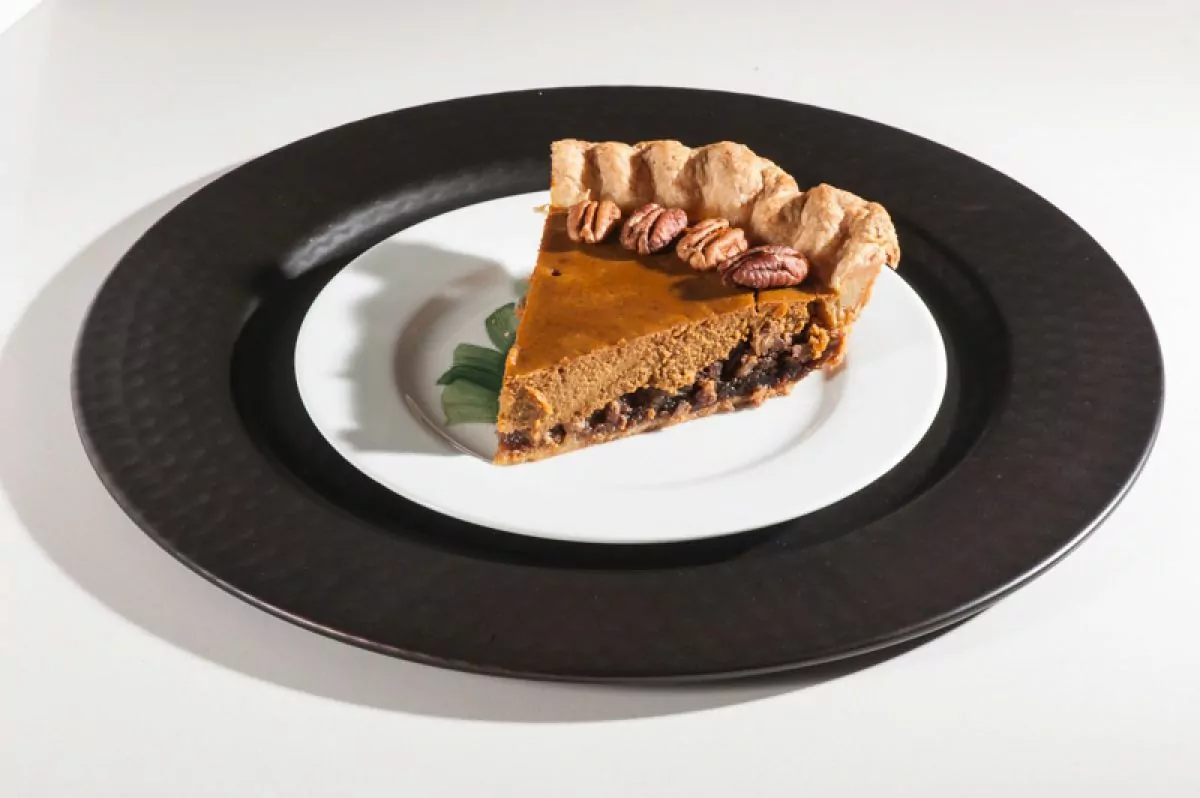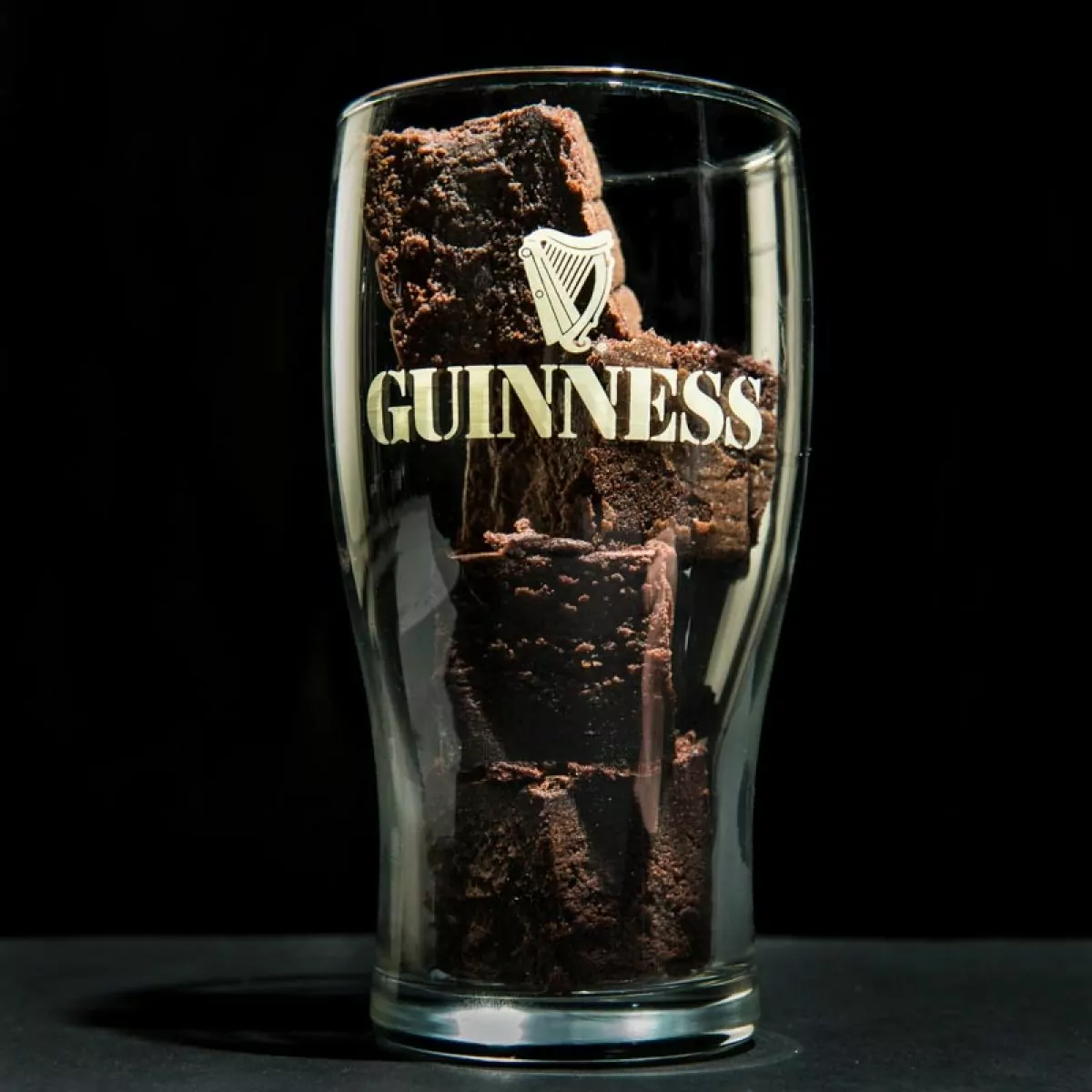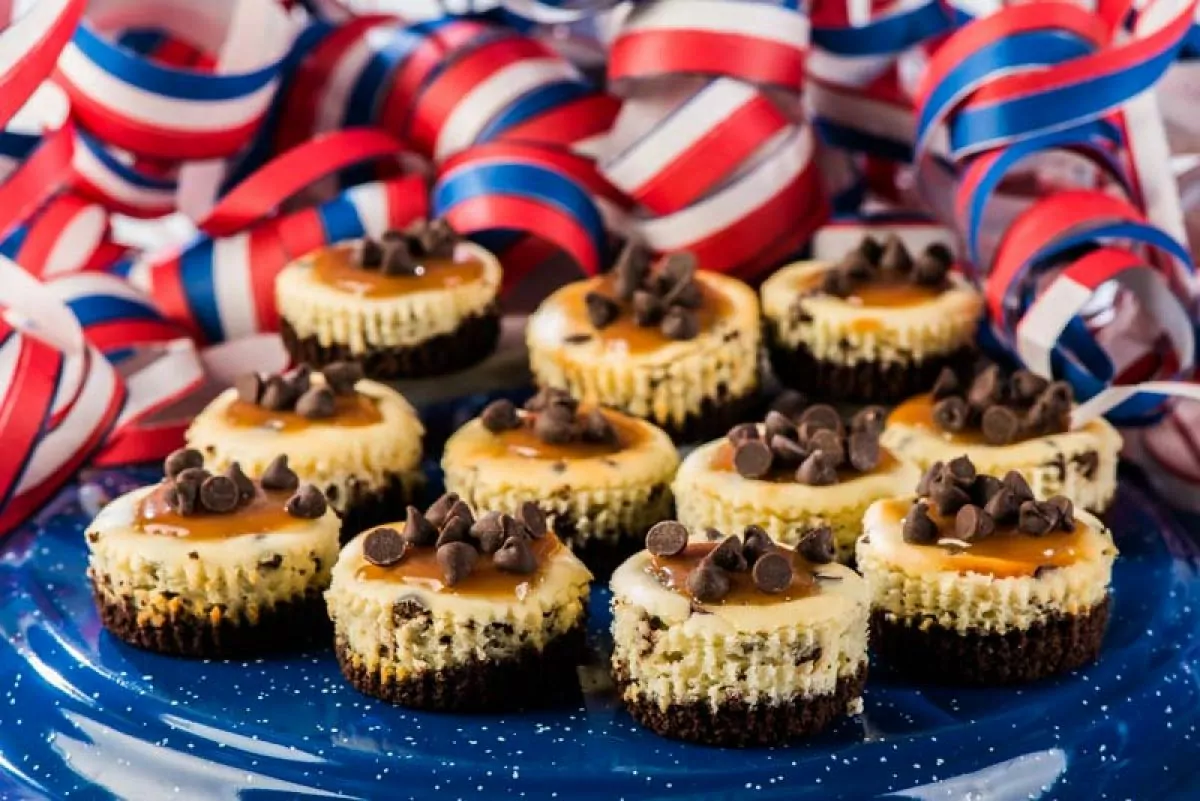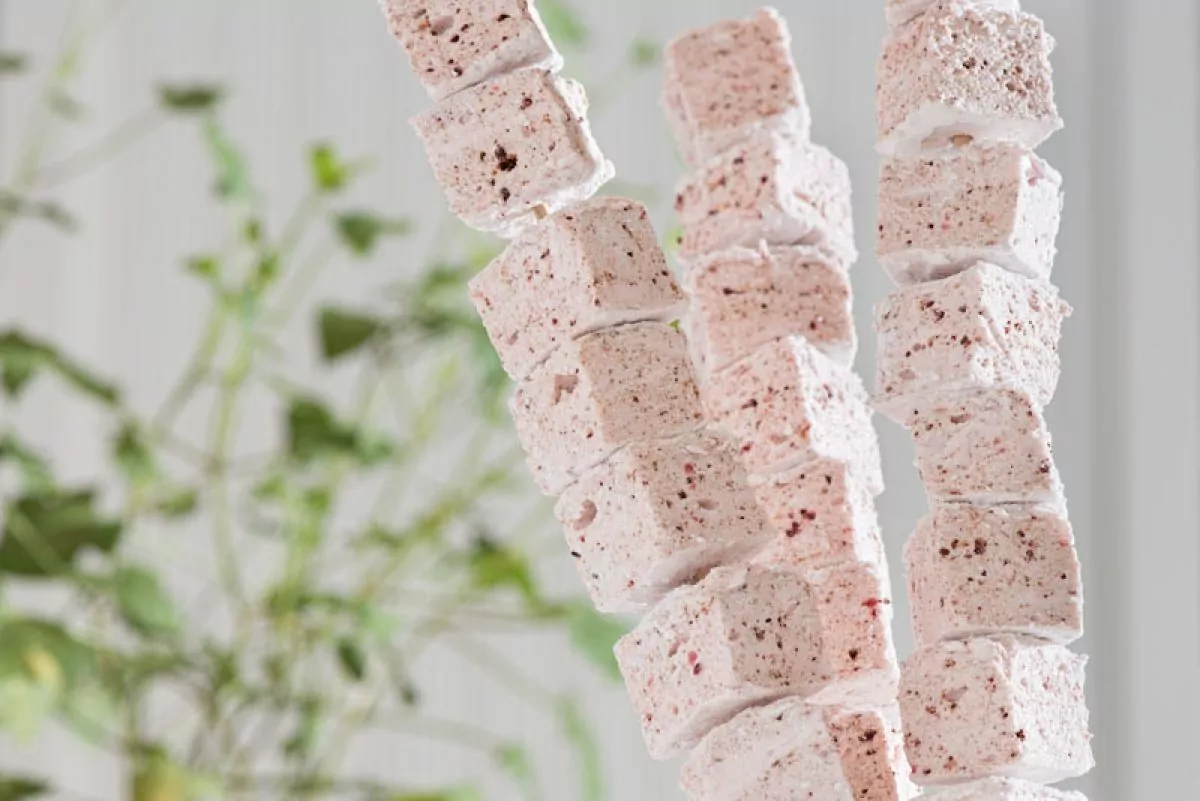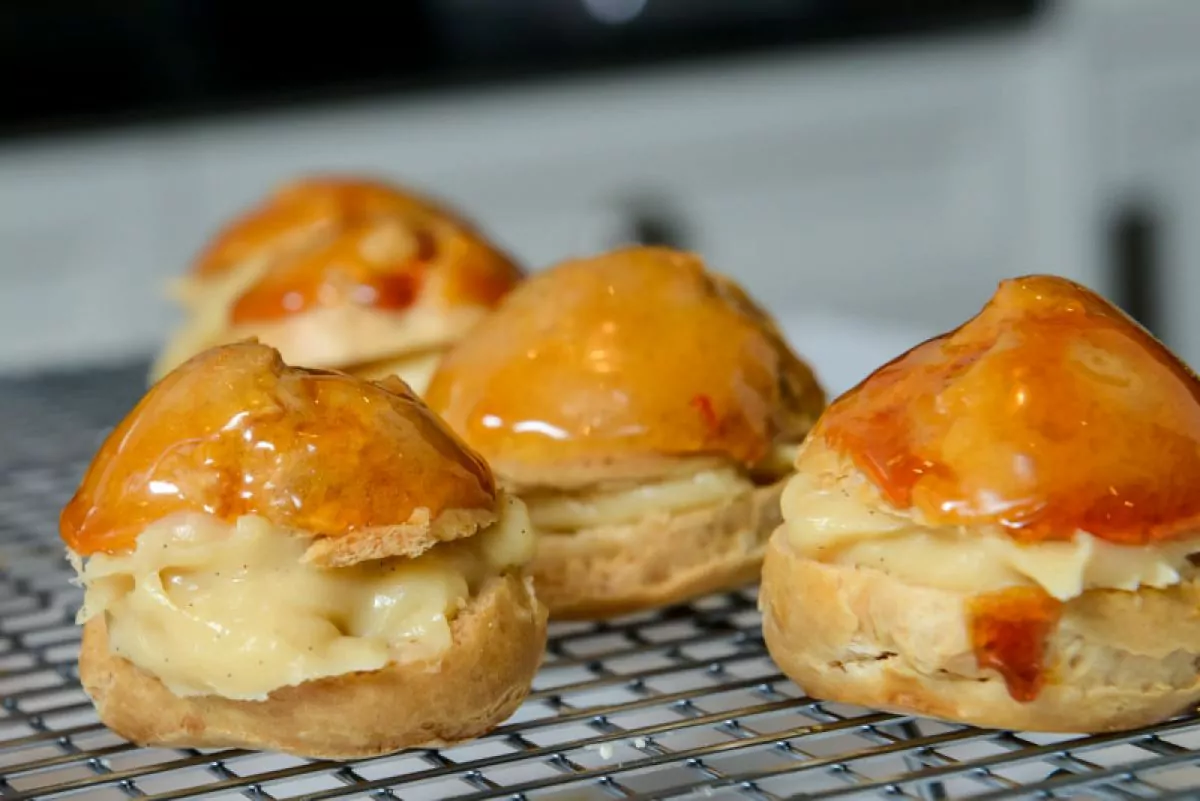
Pâte-à-Choux Filled with Rhubarb and Ginger Cream
April 17, 2016
Pâte-à-Choux filled with Rhubarb and Ginger Cream signals spring. Blend rhubarb syrup into pastry cream to create a seductive springtime pucker. The add spicy ginger juice and a little salt. Together they brighten and balance the acidity. Yeah! The rhubarb, ginger and salt make a mouthwatering pastry cream to fill the crunchiest choux pastry.
Today, I am joined by a group of talented bloggers from the Sunday Supper Movement to Welcome Spring event with a collection of delicious spring recipes. I’m very proud to contribute to the event– Pâte-à-Choux filled with Rhubarb and Ginger Cream. I expect you’ll find the flavours springtime-fresh and engaging, bite-after-bite.
Before launching into the details of this post, I’d like to acknowledge the expertise of Shirley Corriher and her book BakeWise. I have learned so much from this book and highly recommend it. The Pâte-à-Choux recipe is hers.
The Finer Cookie is a participant in the Amazon Services LLC Associates Program, an affiliate advertising program designed to provide a means for websites to earn advertising fees by advertising and linking to amazon.com. This post contains affiliate links, which means The Finer Cookie will receive a small commission if you make a purchase using this link. This modest income helps support the website.
Ingredients
1 Recipe of Pâte-à-Choux (See Recipe Below)
- 1 1 1 recipe of rhubarb syrup
- 1 1 1 recipe of ginger syrup
- 1 1 1 recipe of pastry cream
- 1 1 1 recipe caramelized sugar
Rhubarb Syrup Ingredients
- 2 lbs 2 lbs (8 cups) 32 ounces fresh or frozen rhubarb
- 2 cups 485 grams 16 ounces of water
- 1 cup 198 grams 7 ounces sugar
Ginger Juice Ingredients
- 1 large piece, about 6 inches, of 226 grams-340 grams 8 ounces - 12 ounces fresh ginger-- one big hunk (the fresher the ginger, the more juice it will yield)
Ingredients for Choux Pastry
- 6 large 300 grams (6 large) 10.5 ounces (6 large) eggs, in the shells
- 1 cup 237 grams 8 ounces water
- 4 tablespoons 57 grams 2 ounces unsalted butter
- 1/2 teaspoon 3 grams 1/2 teaspoon fine salt
- 1/2 teaspoon 2 grams 1/2 teaspoon sugar
- 1/4 teaspoon 1/4 teaspoon 1/4 teaspoon vanilla extract
- 1 cup 162 grams 5.7 ounces bread flour (see note on bread flour)
- 1 1 1 large egg beaten, for glaze, optional
Ingredients for The Pastry Cream
- 1/2 cup 98 grams 3.5 ounces sugar
- 2 pinches 2 pinches 2 pinches fine salt
- 1/4 cup 37.5 grams 1.1 ounces bleached flour
- 1/4 cup 28 grams 1 ounce cornstarch
- 1 cup 226 grams 8 ounces whole milk
- 1 cup 1 cup 1 cup of rhubarb syrup (recipe above)
- 4 teaspoons 4 teaspoons 4 teaspoons ginger juice (recipe above)
- 1/2 1/2 1/2 vanilla bean split in half with seeds removed
Caramelized Sugar Syrup
- 2 cups 396 grams 14 ounces white sugar
- 1/2 cup 4 ounces 4 ounces of water
- 1/16 teaspoon 1/16 teaspoon 1/16 teaspoon cream of tartar

Instructions
COOK THE RHUBARB
- Combine the rhubarb, water and sugar and bring it to a simmer.
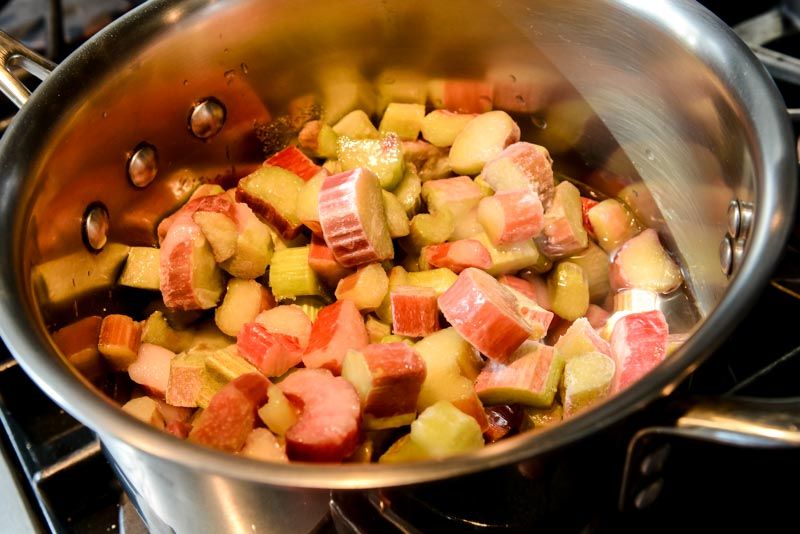
- Cook until the rhubarb has completely broken down and the syrup is light pink.
- Strain out the liquid to a smaller, clean saucepan and press the pulp to release as much liquid as possible. You should have about 3 1/2 cups of syrup.
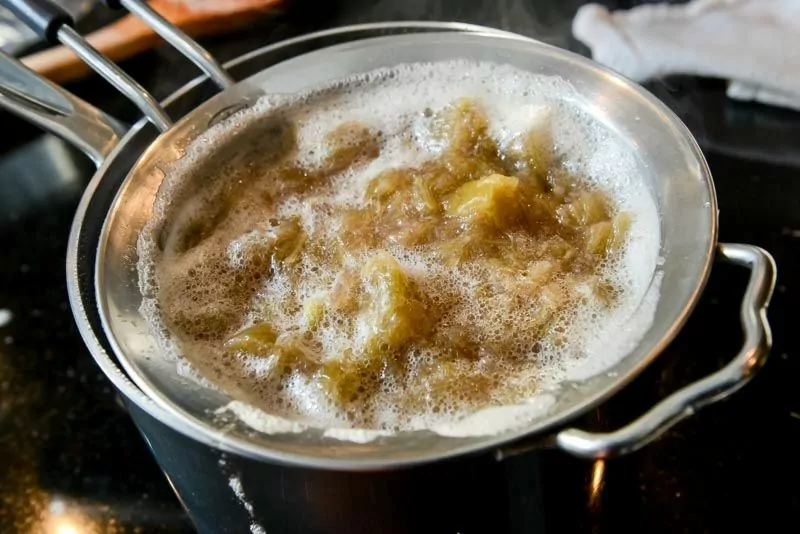
- Continue to simmer, reducing the syrup to 1 1/2 cups. This will take about 45 minutes.
- Let the syrup cool until it’s just warm.
MAKING THE GINGER JUICE
- Cut a 12″ square of double layer cheesecloth.
- Peel the ginger and grate it directly onto the piece of cheesecloth.
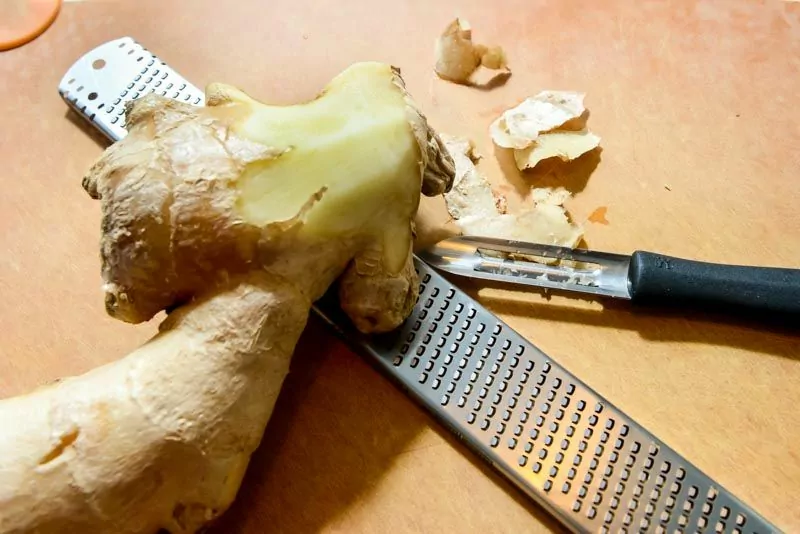
- Gather up the four corners of the cheesecloth and twist it until it’s tight and oozing ginger juice.
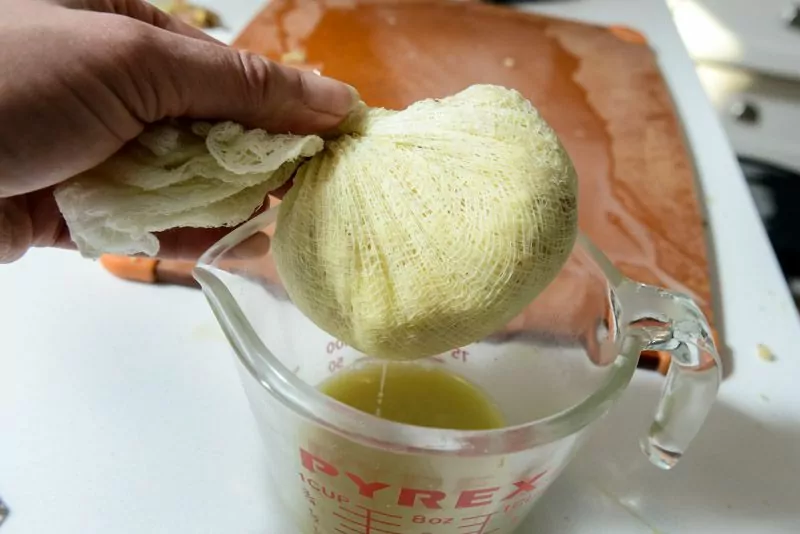
- Squeeze the juice into a glass container.
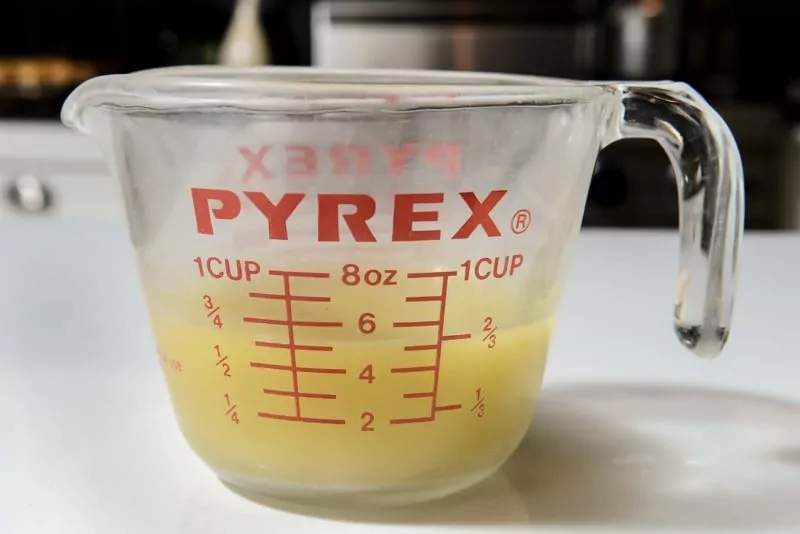
MIS EN PLACE FOR THE CHOUX PASTRY
- Preheat the oven to 450ºF/232ºC with a shelf on the lower third of the oven. Set a baking stone on the shelf.
- On the floor of the oven set a baking tray, cast iron pan lined in foil (to prevent rust), or set some other heat resistant container on the floor of the oven. This will be used to create steam when the choux’s are baking.
- Place the six eggs in their shell in a bowl covered with hot tap water. Let the water cool and repeat. The idea is to warm the eggs.
- Separate 2 of the eggs and store the egg yolks for another use. Place the 2 egg whites in a liquid measuring cup. See The Finer Cookie’s article on how to separate eggs.
- Add the remaining 4 whole eggs into the same measuring cup. Cover in plastic (to avoid evaporation) and set aside.
- Crack another egg into a smaller bowl for the glaze on the choux pasteries (optional). Cover with plastic wrap (to avoid evaporation).
- Ready a pastry brush. Set aside.
- Weigh the butter, water, and salt in a medium saucepan and set aside. Read more here about how to weigh and measure.
- Weigh the bread flour into a separate bowl and and set aside.
- Measure the vanilla and sugar into another bowl and set aside.
- Prepare the baking sheet with a silicone mat, or parchment.
- Get out a heavy wooden spoon and a dough whisk. Set them aside too.
- Insert a 1/4″ round piping tip into the pastry bag. To make it easier and less messy to fill, set the empty bag in a tall glass and open the bag over the rim of the glass. This will keep the outside of the bag cleaner.
- Set up the stand mixer with a paddle attachment.
ASSEMBLE THE CHOUX PASTRY
- Turn on the heat and bring the water, butter and salt to a full boil.
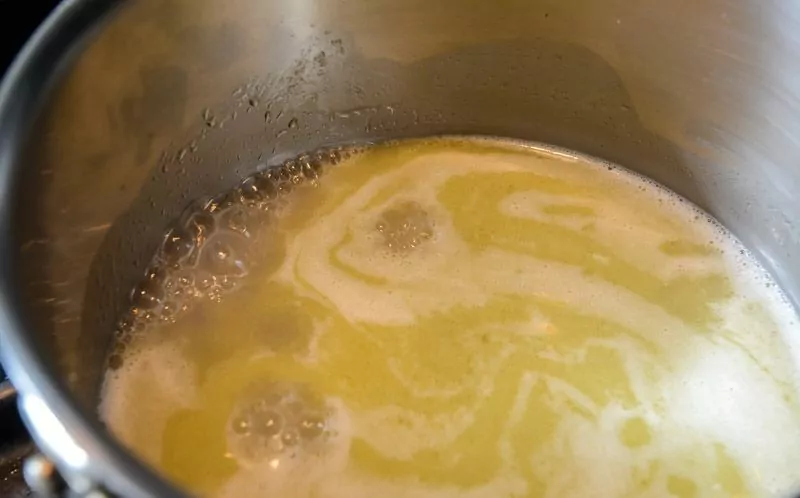
- Once it is boiling, remove it from the heat and add the flour all at once. This is important because you’ll want the flour to absorb the liquid evenly.
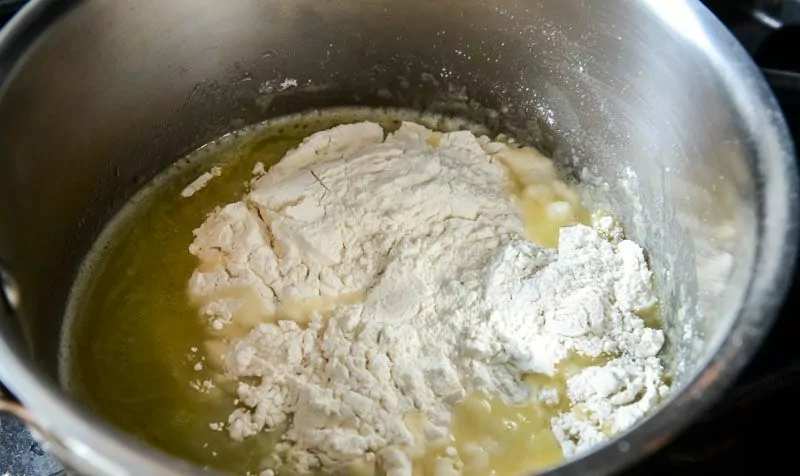
- Stir vigorously with the dough whisk until the mass comes together.
- Return the pan to medium heat and stir the batter until a film begins to develop on the bottom of the pan, and steam starts to rise from the dough. (see above Note on Bread Flour above for further instruction.)
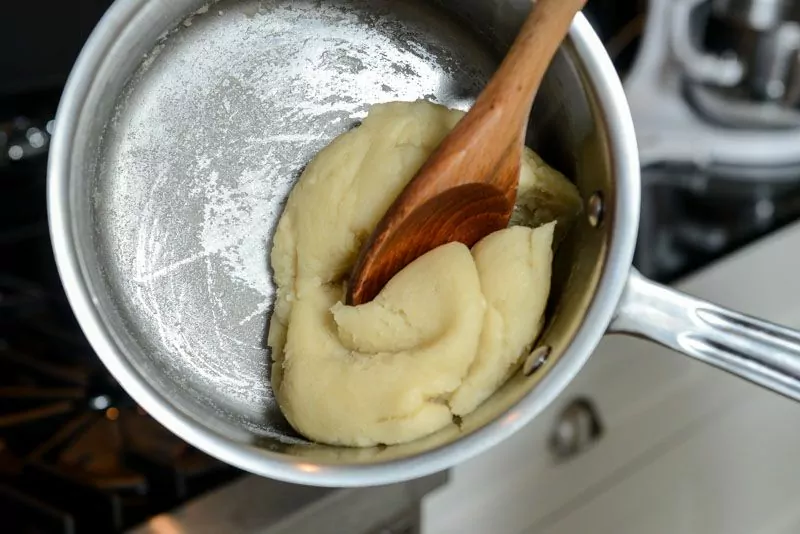
- Continue stirring over the heat for about 3-5 minutes. A hand held mixer comes in handy at this stage because it will help release steam and save your shoulder. Avoid browning the dough.
- Transfer the warm dough to the bowl of the stand mixer fitted with the paddle attachment and turn the mixer to the stir setting. You will see big clouds of steam rise from the mixing bowl. This is good. Let the mixer run for a minute or two more to release as much moisture as possible.
- Gather the dough against the side of the bowl.
- Add about ¼ cup of warm egg to the dough and mix gently until incorporated.
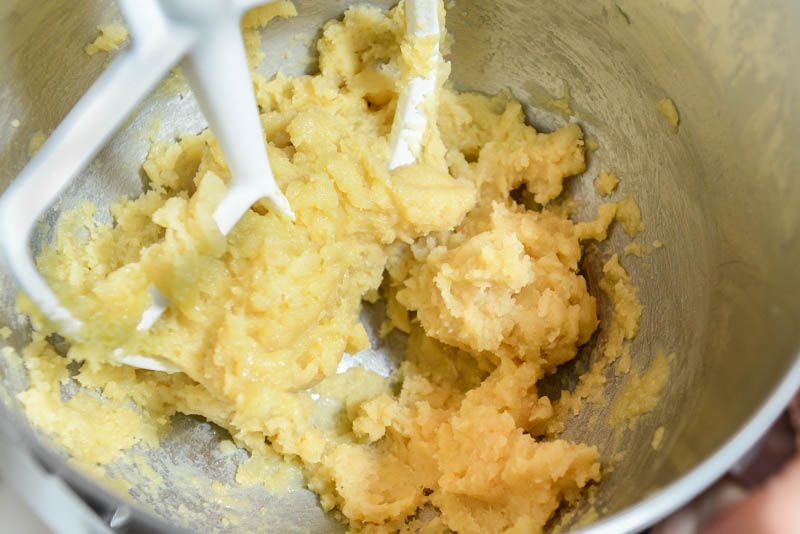
- Once the egg is incorporated, add another ¼ cup of warm egg.
- If you’ve dried the dough thoroughly, it should be able to absorb the entire cup of eggs.
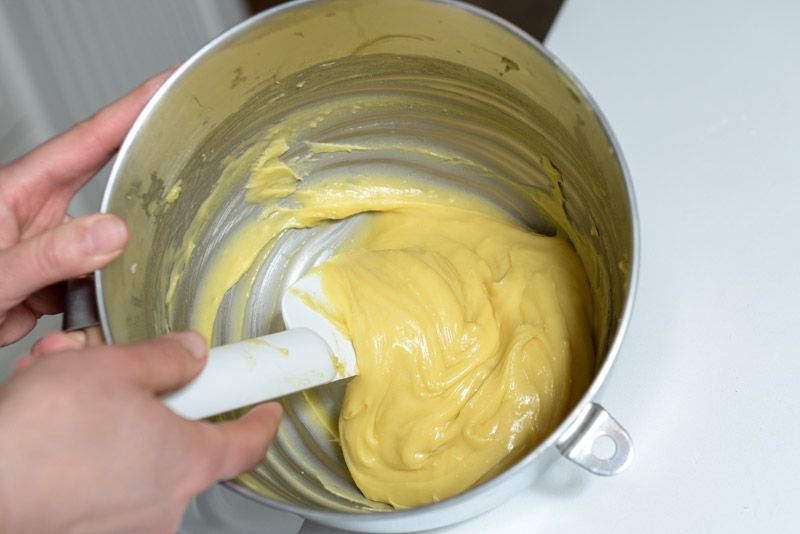
- Form the Choux immediately as they achieve the best puff when the batter goes into the oven warm.
FORM THE PÂTE-À-CHOUX
- Spoon the batter into an 18″ pastry bag with a 1/2 inch tip. Push the batter toward the tip and twist the bag closed.
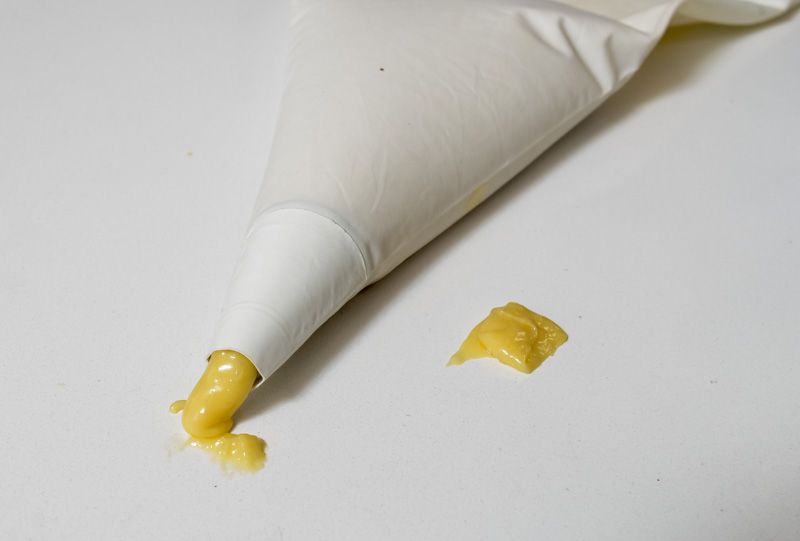
- Applying even pressure, pipe small round blobs of dough about 1-1 ½ inches in diameter and tall. If the dough is the proper consistency, the chouxs will hold their shape and not spread.
- Pipe 4 across and 5 down giving you 20 choux per tray.
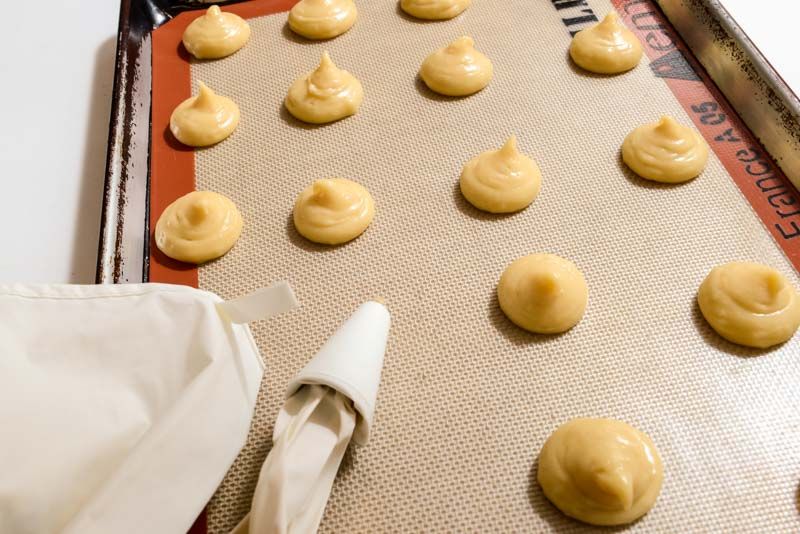
- Very gently, dab the choux’s with egg being careful not to let it drip onto the tray or it will prevent them from rising fully. This step is optional.
BAKING THE CHOUX PASTRY
- For the best rise, bake one tray at a time only with heat from the bottom elements. The crust will set too quickly with the top element on, preventing the maximum rise. Just so you know, I’ve baked two trays at a time with reasonable success, not maximum success.
- Once the oven is at 450ºF/232ºC, fill a dry cup measure with ice cubes. While wearing oven mitts, slide the tray onto the bottom shelf of the oven and very quickly pour the ice cubes into the hot pan sitting on the oven floor, then shut the door as quickly as possible. The steam from the melting ice cubes will create a moist environment and will give you the best rise possible.
- Turn the heat down to 425ºF/218ºC (from 450ºF/232ºF) and bake for about 20-25 minutes. If you’re baking two trays at the same time, rotate the pans.
- Turn down the oven again to 350ºF/177ºC and bake for another 10 minutes or so to give them time to dry out and brown nicely.
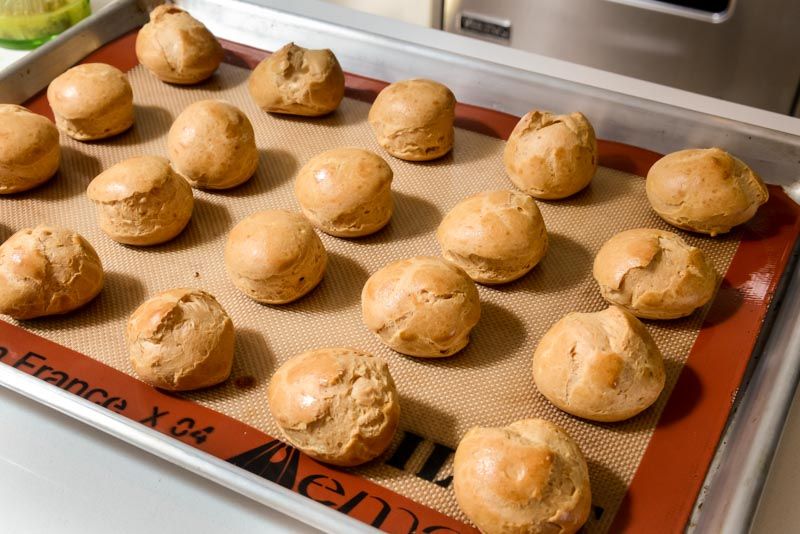
COOLING THE CHOUXS
- Cut a small slit in each choux to release the steam and set them on a rack to cool completely.
- They can be used right away or frozen for up to two months, or stored in a plastic bag or container in the short term. If while in the bag, they soften, let them dry in the open air.
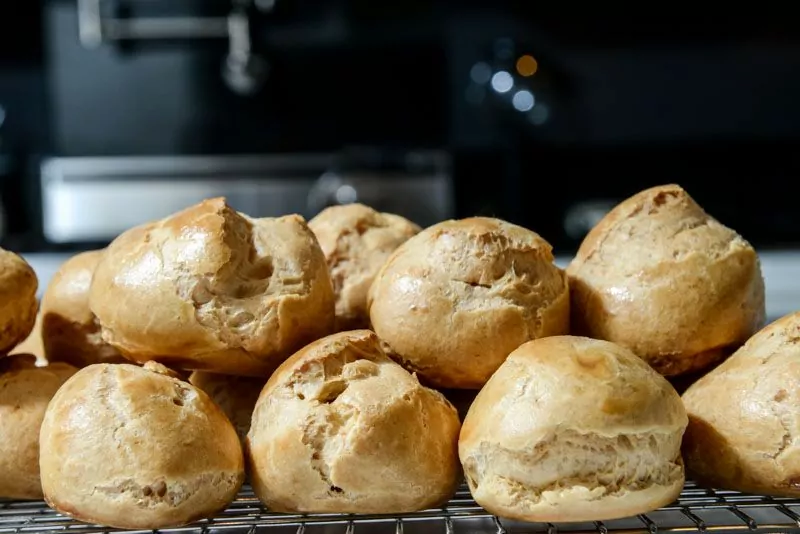
MIS EN PLACE FOR THE PASTRY CREAM
- Separate the eggs and place the egg yolks in a wide mouth heavy saucepan.
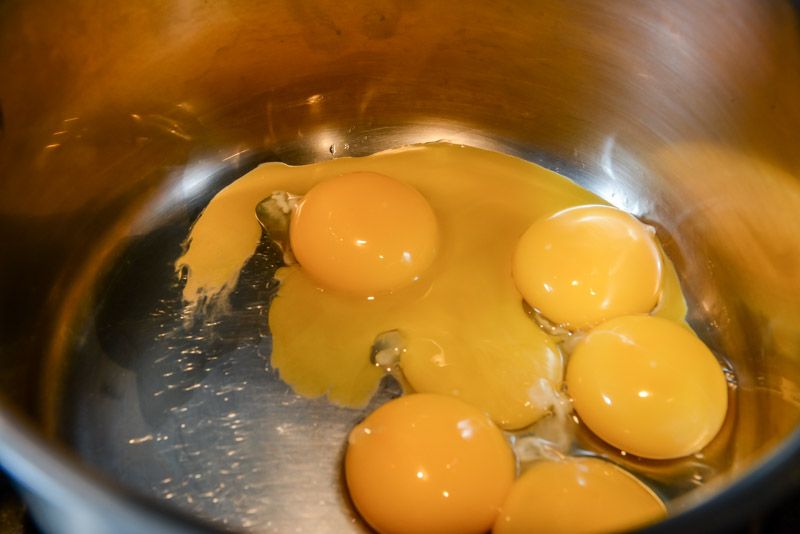
- Measure the sugar and salt in a small bowl and set a side.
- Separate the vanilla bean and scrape the seeds into the sugar and pinch the sugar and vanilla seeds together so that the seeds break up and incorporate into the sugar.
- Weigh or measure and blend the cornstarch and flour in a separate bowl.
- Combine the milk and rhubarb syrup and heat for 1 minute in the microwave.
ASSEMBLING THE PASTRY CREAM
- Whisk the egg yolks, sugar, vanilla bean and salt in the cold saucepan until light in color.
- Sift the cornstarch and flour onto the egg/sugar mixture.
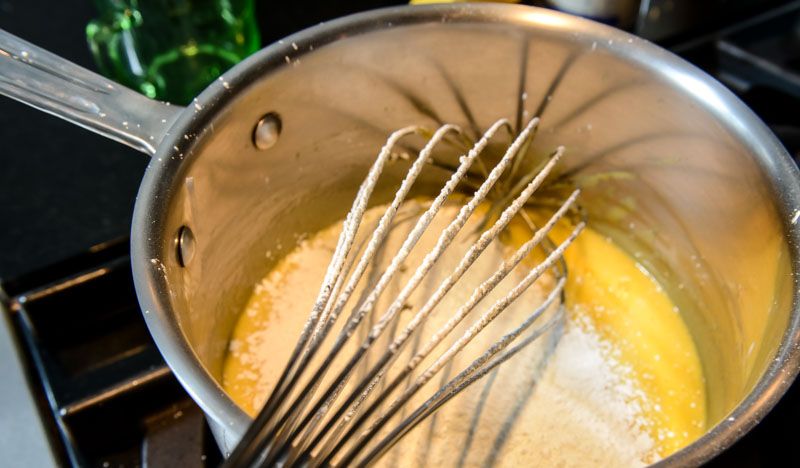
- Whisk them together until very smooth.
- Slowly pour in the rhubarb and milk and whisk to combine. Add the vanilla pod for extra flavour.
- Set the saucepan over medium heat and change to a rubber spatula.
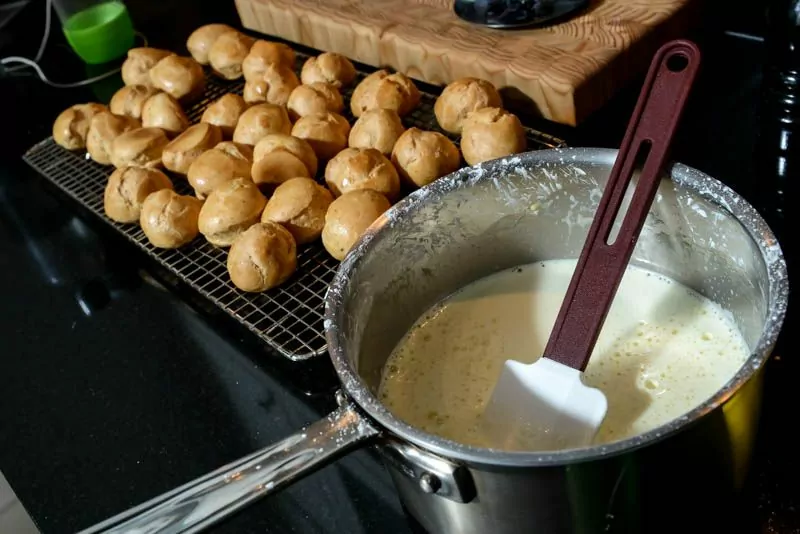
- Stir constantly until the pastry cream begins to warm up. The cornstarch is heavy and will want to sink and collect at the bottom of the pan. Stirring will keep the cornstarch suspended as it activates and thickens the liquid. If you begin to feel a thick layer forming, switch back to the whisk and whip vigorously until the cream emulsifies. This is important to keep the pastry cream smooth.
- Once the pastry cream thickens up, add the ginger juice and remove the vanilla bean.
- Let the pastry cream cool.
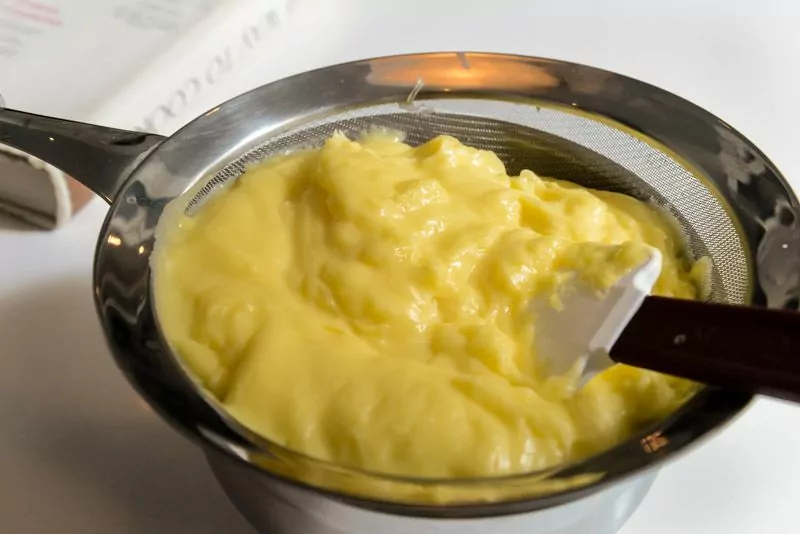
COOKING THE SUGAR
- Combine the sugar, water and cream of tarter in a small saucepan.
- Turn on the heat to medium and stir until the sugar dissolves.

- Stop stirring and let the temperature rise slowly.
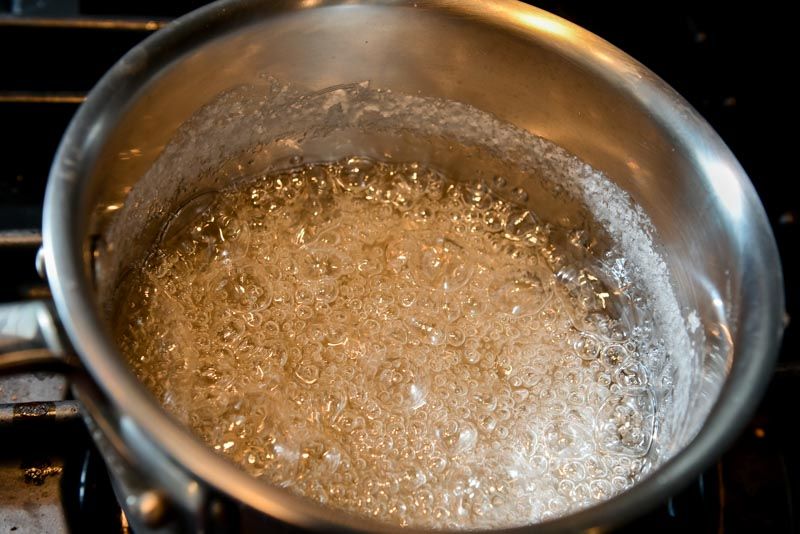
- Use a candy thermometer and test the temperature.
- Continue boiling without stirring until the temperature reaches 360ºF
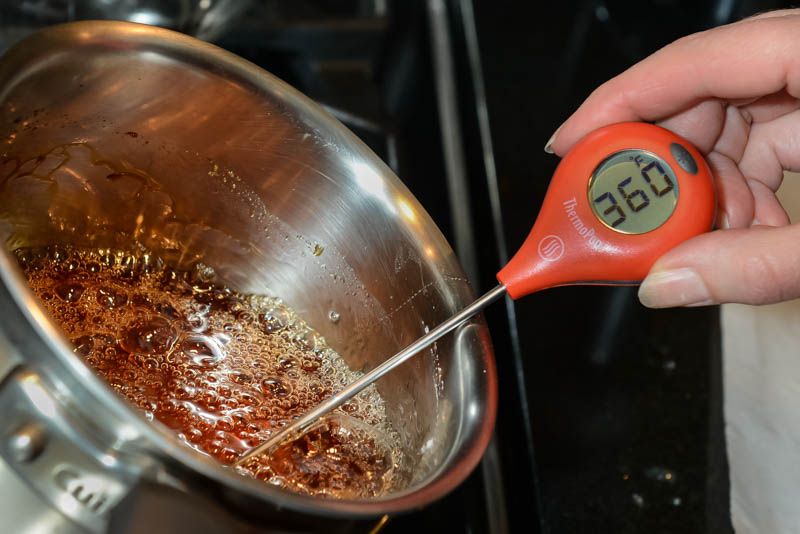
- Remove the pan from the heat just before it hits 360º because the sugar will continue to cook.
DIPPING THE CHOUXS IN THE SUGAR
- Dip the chouxs in the caramelized sugar about halfway, being very careful not to burn yourself.
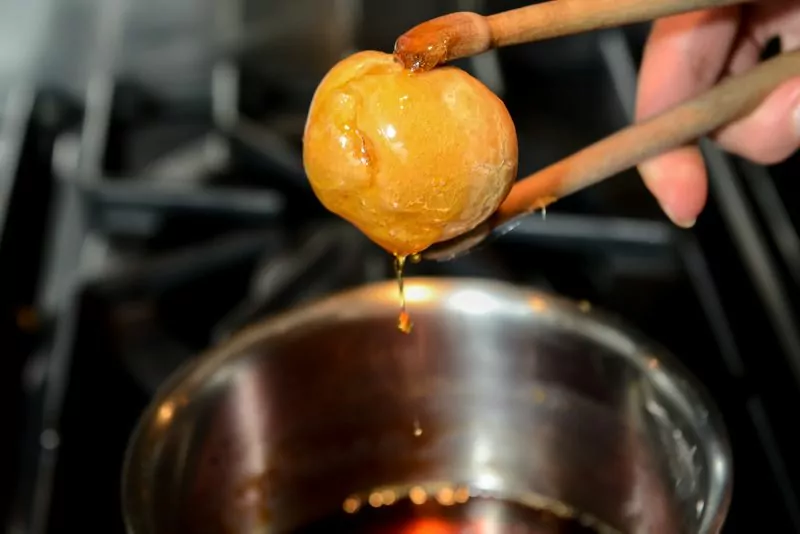
- Let the Pâte-à-Choux cool on a rack.
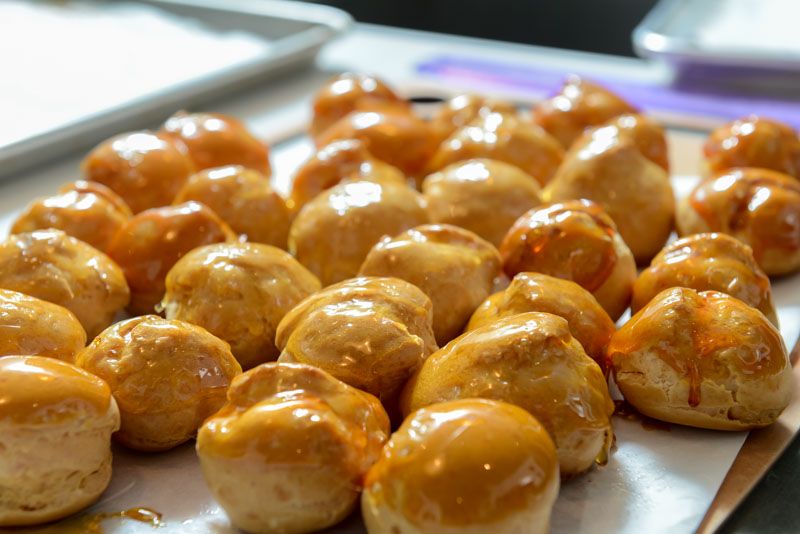
ASSEMBLING THE PÂTE-À-CHOUX
- There are two ways to add the pastry cream to the choux. Either cut it in half and spoon it into the center and top it with the other half.
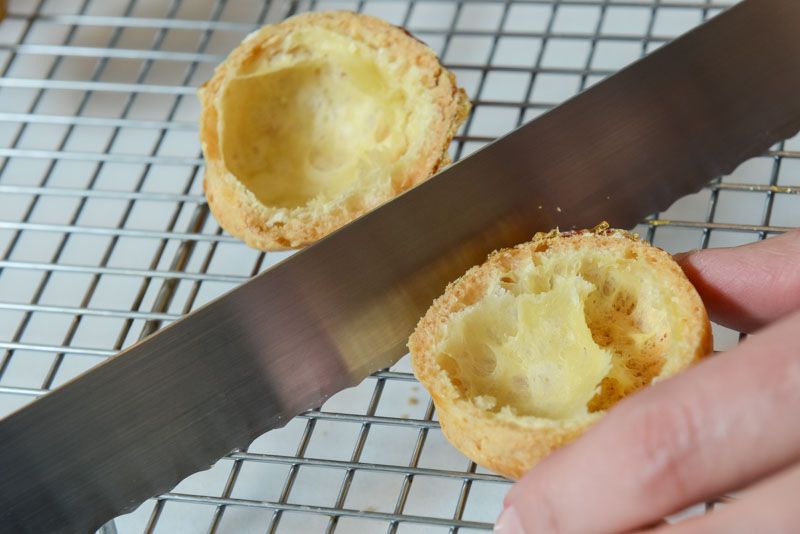
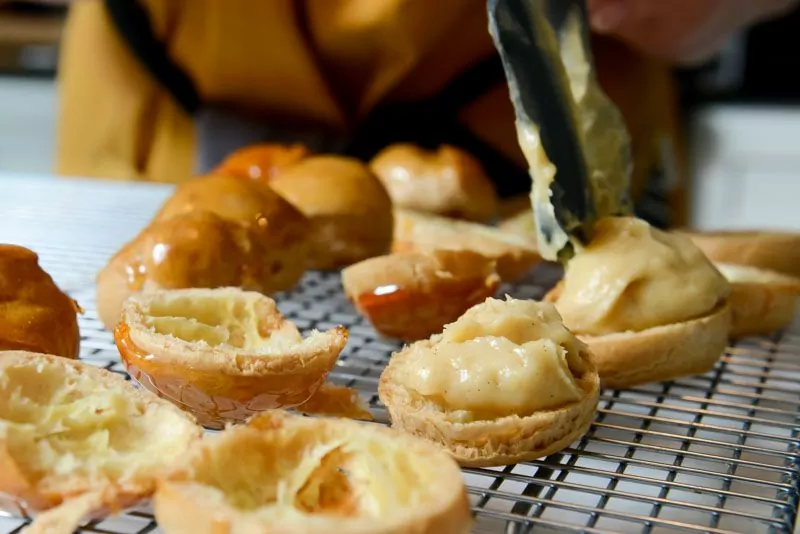
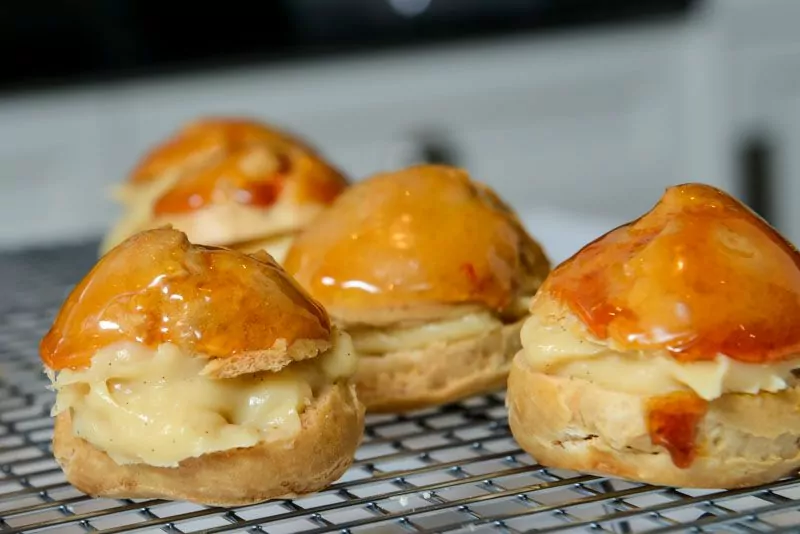
- OR, fill a pastry bag with the pastry cream fitted with a star tip and pipe the cream into the choux and top it with the other half.
- OR, fill a pastry bag with the pastry cream fitted with a plain round tip. Don’t cut the choux in half and poke the tip into a convenient opening, gently squeezing a small amount of cream into the open cavity of the choux.
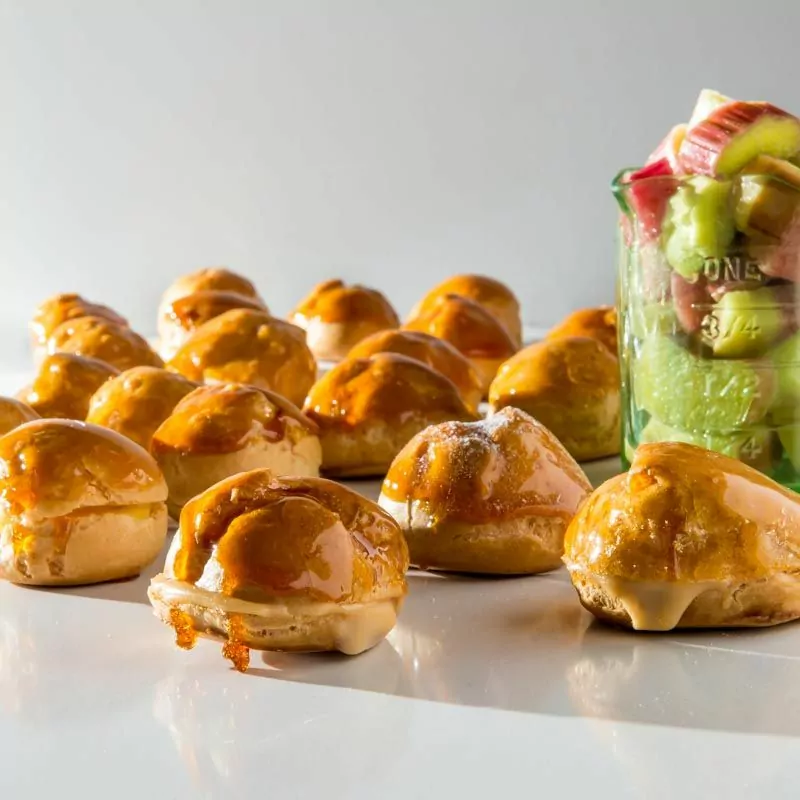
NOTE ON THE SWEETNESS
The sugar in this recipe is adjusted so that the final pastry cream will be flavourful with moderate sweetness. If you want, you can reduce the sugar to 1/2 cup in the rhubarb syrup to give the final pastry cream even more pucker.
NOTE ON THE BREAD FLOUR
I know using bread flour for Choux Pastry is unconventional; however, it produces a very crisp, dry shell. It’s better because the bread flour has a higher protein count and absorbs more liquid than all-purpose flour. The dough will be stiffer and more difficult to stir by hand. That’s why I pull out my trusty hand mixer to help me. Simply turn on the hand mixer to its lowest setting for about 1 minute, then stir again with your wooden spoon. The dough will melt together into a single mass. Magic. If bread flour is unavailable, use all-purpose flour and do an extra good job drying out the dough so it’s able to absorb all the egg.
IMPORTANT TO YOUR SUCCESS
The goal during cooking is to create a very dry dough by releasing as much water/steam as possible. The dryer the dough, the more egg it will accept/absorb without losing its thick consistency. The more egg that’s incorporated, the more puff and rise you’ll get during baking.
NOTE ON USING A STAND MIXER VERSUS A FOOD PROCESSOR
Some people prefer using a food processor to incorporate the egg. I don’t think a FP incorporates the egg as well as the stand mixer or a hand held mixer. I feel the mixer produces the lighter, puffier choux pastry.
IMPORTANT NOTE ON THE FINAL CONSISTENCY OF THE CHOUX BATTER
The final consistency of the batter should be thick enough to hold their shape when spooned or piped into small blobs/balls. As you add the egg, assess the thickness of the batter. The batter must be visibly thick. If it was thick one moment then runny the next DON’T PANIC. Let the batter sit for 10-15 minutes, during which time the bread flour will absorb the liquid, and you’ll find it a better consistency.
ALSO
If you see little flour seeds in the batter, beat the batter on medium speed for another minute or two. It should smooth out at this point.
NOTE ON THE THICKNESS OF THE PASTRY CREAM
The goal is to have a flavourful cream that is thick enough to hold its shape when spooned or piped. Be sure to add all of the flavouring into the warm pastry cream. As the cream cools, the cornstarch especially becomes thicker. Stirring it after will break the bonds and cause the cream to loose
- Tags
- Ginger,
- Pate A Choux
